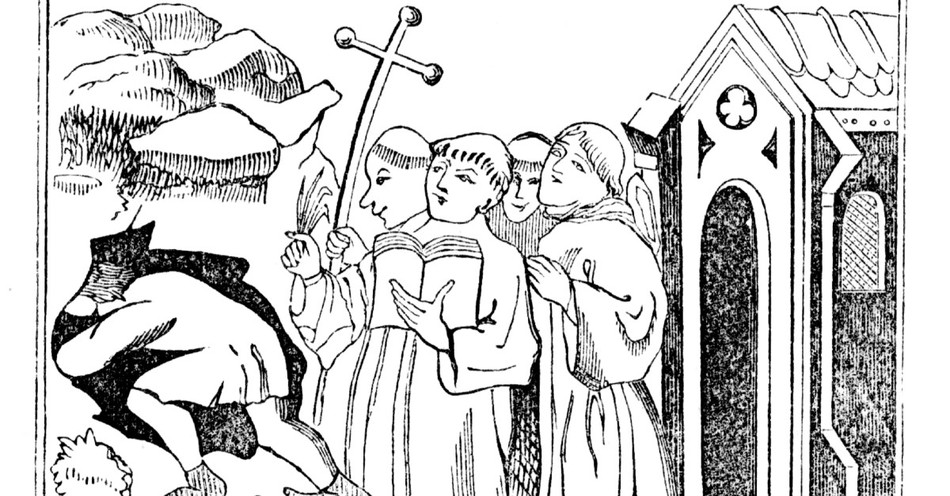Patrick was born over 1,600 years ago about 389 AD He was the next great Christian missionary that we know of after the Apostle Paul, even though he wasn't born for over 300 years after Paul's death.
His impact was so profound it is not surprising that his life became embellished with legends. But even if Patrick did not drive the snakes out of Ireland, such a legend testifies to the pervasive power of his ministry. Fortunately we have two documents from Patrick himself that give us valuable information about him. They are his Confession, written near the end of his life, and his Letter to Coroticus, his urgent plea to a king who had captured many of his converts. Following is a sampling of highlights from Patrick's life and an excerpt from his confession of faith.
From Patrick's Confession
I was sixteen years old and knew not the true God and was carried away captive; but in that strange land (Ireland) the Lord opened my unbelieving eyes, and although late I called my sins to mind, and was converted with my whole heart to the Lord my God, who regarded my low estate, had pity on my youth and ignorance, and consoled me as a father consoles his children...Well every day I used to look after sheep and I used to pray often during the day, the love of God and fear of him increased more and more in me and my faith began to grow and my spirit stirred up, so that in one day I would pray as many as a hundred times and nearly as many at night. Even when I was staying out in the woods or on the mountain, I used to rise before dawn for prayer, in snow and frost and rain, and I felt no ill effect and there was no slackness in me. As I now realize, it was because the Spirit was glowing in me.
St. Patrick's Breastplate
This famous prayer, one of the earliest known European vernacular poems, has been attributed to Patrick, but scholars say some of the words used indicate the versions available come from a later period. But there is no question that they ooze the spirit and content we see in Patrick's Confession, and they vibrate with the power of Christianity that Patrick gave to his adopted land. Some Christians today find great value in memorizing this classic prayer and repeating it each morning upon arising.
I arise today
Through a mighty strength, the invocation of the Trinity.
Through belief in the threeness,
Through confession of the oneness
Of the Creator of Creation.I arise today
Through the strength of Christ's birth with his baptism,
Through the strength of his crucifixion with his burial,
Through the strength of his resurrection with his ascension,
Through the strength of his descent for the judgment of Doom...I arise today
Through God's strength to pilot me:
God's might to uphold me,
God's wisdom to guide me,
God's eye to look before me,
God's ear to hear me,
God's word to speak for me,
God's hand to guard me,
God's way to lie before me,
God's shield to protect me,
God's host to save me
From snare of devils,
From temptations of vices,
From everyone who shall wish me ill,
Afar and anear,
Alone and in multitude.I summon today all these powers between me and those evils,
Against every cruel and merciless power that may oppose my body and soul
Against incantations of false prophets,
Against black laws of pagandom,
Against false laws of heretics,
Against craft of idolatry,
Against spells of witches and smiths and wizards,
Against every knowledge that corrupts man's body and soul.Christ to shield me today
Against poison, against burning,
Against drowning, against wounding,
So that there may come to me abundance of reward.
Christ with me, Christ before me, Christ behind me,
Christ in me, Christ beneath me, Christ above me,
Christ on my right, Christ on my left,
Christ when I lie down, Christ when I sit down, Christ when I arise,
Christ in the heart of every man who thinks of me,
Christ in the mouth of everyone who speaks of me,
Christ in every eye that sees me,
Christ in every ear that hears me.I arise today
Through a mighty strength, the invocation of the Trinity,
Through belief in the threeness,
Through confession of the oneness,
Of the Creator of Creation.
A Shining Light in a Dark Age
It's an incredible and largely unknown story. It's told in How the Irish Saved Civilization (Doubleday, NY 1995), Thomas Cahill's excellent book on St. Patrick and his spiritual descendants. Though located at what was perceived to be the edge of the world, the hearty Irish who succeeded Patrick emerged as one of the most vital missionary and educational movements in all history.
As wave after wave of German barbarians swept over the Roman empire in the fifth and sixth centuries, Roman political structure disintegrated, and centers of learning and education disappeared. Some call this period the Dark Ages, when civilization itself seemed on the verge of vanishing. During this dismal time, it was the Irish who preserved the books and learning of the classical and Christian authors.
Ireland was one part of Europe which had never been part of the Roman Empire, and their Celtic Christianity was distinctly un-Roman. Not connected with the papal system or the Roman hierarchy, Celtic Christianity developed around individual leaders and monasteries, and the Irish monks were leaders in spreading and preserving the Christian faith.
Many priests and monks from England and the continent fled to monasteries in Ireland to escape the barbarian invaders. Some came from as far as Egypt, Syria, and Armenia. The study of the Scriptures was central to the Celtic monastic schools, and the scriptorium was a key part of the monastic compound. Here the monks carefully copied the Scriptures and many of the Greek and Latin classics. Many of the earliest Latin manuscripts available today are those made by the Irish monks, and over half of our Biblical commentaries between 650 and 850 were written by Irishmen. For them, writing was an art. Using seashells and plant juices for color, they decorated the manuscripts with the most elaborate designs.
Leaving their homeland and carrying the gospel elsewhere was an important part of the Irish Christian tradition. It was these traveling monks who kept Christian literacy alive in barbarized Europe. In the century after Patrick, the Irish monk Columba established the monastery of Iona off the west coast of Scotland and began to create a literate, Christian society among the Scots and Picts of north Britain. His followers later went to Lindisfarne and began the same transformation among the Angles of Northumbria. Other Irish monks went to the mainland and established at least 60 monasteries throughout France, Germany, Switzerland, and Italy. Traces of their work can be found as far east as Kiev in Russia and as far west as Iceland.
Celtic Christianity differed from Roman Catholic Christianity in a number of ways. The Irish did not have an authoritarian church hierarchy, and the monks looked more to Scripture than tradition for their rule. They also followed a method of dating Easter common in the eastern churches. The Irish introduced a system of private confession and penance, practices later adopted by the Roman church.
Viking invasions of the eighth and ninth centuries disrupted the Celtic monasteries in Britain and Ireland. By then, however, the Irish had already planted the seeds of Christian learning throughout Europe.
And, as Cahill points out, "In all disasters, Patrick would insist, there is ground for hope." Indeed, Patrick would probably even find hope for us today.
If you have enjoyed this special issue, then give your favorite Irish friend a big hug.
Patrick: A Fourth Century Prodigal Son
- He was born about 389 AD in a family of Celtic Christians.
- Patrick rejected his family's Christian faith and had no desire for God.
- When he was about 15 a marauding gang of pirates kidnapped him, took him to Ireland, and forced him into slavery.
- He served his Irish master as a shepherd. His education was interrupted. For the rest of his life he was self-conscious about his lack of education and eloquence.
- During his captivity he had a profound conversion experience that changed the course of his whole
life. (See excerpt from his Confession below)
- He was able to escape after six years and return to his homeland and parents.
- Then one night Patrick had a vision: I saw a man named Victorious, coming as if from Ireland, with innumerable letters; and...I read...'The voice of the Irish' and while I was reading...I - heard the voice...'Please, holy boy, come and walk with us again.
- Against his parent's wishes he returned to Ireland to bring the Gospel of Christ.
- He spent some thirty years there and evangelized and baptized many thousands, some estimate over one hundred thousand. He lost count. Some two hundred churches were established. - His ministry confronted and challenged pagan practices there such as infants sacrificed to harvest gods, prisoners of war sacrificed and their skulls used as ceremonial drinking bowls.
- He also spoke out unequivocally against human slavery, and some say he was the first to do so.
- Patrick often annoyed his church members in Ireland because he would return their gifts and the jewelry they wanted to give him.
- His work through his successors brought a shining light to the so-called "Dark Ages."
Is Patrick Only for Catholics?
For those of you who think St. Patrick belongs only to the Irish Catholics, you should know that Patrick himself was neither Irish nor Roman Catholic. He was a Briton by birth. And he was part of Celtic Christianity which in his day was independent from Rome. As you saw in the section above, "A Shining Light in a Dark Age," there is a sense in which Patrick really belongs to all of us.
Further Reading:
Patrick: From Slave to Missionary
What Can We Learn from the Life of St. Patrick?
Patrick: Making of a Missionary
1st American St Patrick's Day Celebration
What Is St. Patrick's Day All About?
How to Honor St. Patrick This Weekend
(This article first published as "Patrick" on April 28, 2010)
Photo Credit: Getty Images/Christine_Kohler
This article is part of our People of Christianity catalog that features the stories, meaning, and significance of well-known people from the Bible and history. Here are some of the most popular articles for knowing important figures in Christianity:
How Did the Apostle Paul Die?
Who are the Nicolaitans in Revelation?
Who Was Deborah in the Bible?
Who Was Moses in the Bible?
King Solomon's Story in the Bible
Who Was Lot's Wife in the Bible?
Who Was Jezebel in the Bible?
Who Was the Prodigal Son?









